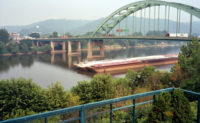The success of engineered systems to capture stormwater runoff from Seattle’s Aurora Avenue Bridge has spurred construction of additional measures that proponents say will increase total filtering capacity by another two million gallons per year.
Constructed in 1929, the cantilever and truss bridge rises nearly 170 feet above the Lake Washington Ship Canal, which connects Lake Union to Puget Sound. Stormwater runoff from the bridge has long carried untreated oil, deicing chemicals, metals and other materials into the waterway, compromising the health of salmon and the orcas that feed on them. The Nature Conservancy reports that stormwater runoff samples for the Aurora Bridge contained a median total suspended solids (TSS) level of 567 mg/L, well above the National Stormwater Quality Database baseline of 99 mg/L.
In 2017, local developer Mark Gray teamed with architect Weber Thompson, KPFF engineers, Pennon Construction Co. and several environmental groups to incorporate a cascading rain garden as part of a new office building adjacent to the Aurora Bridge’s southbound span. That facility’s success in collecting and filtering 200,000 gallons of stormwater annually spurred interest expanding the system with Grey funding construction of a second rain garden in another building project alongside the bridge’s northbound span.
Nearby, a 850-sq-ft bioswale is being built as a public-private partnership involving Boeing, Adobe and other local businesses, and the Washington state legislature. Both projects are set to be completed by the end of March.
In addition, state legislators have allocated $1 million to build similar runoff filtering systems for the I- 5/Ship Canal Bridge on Lake Union’s east side.




Post a comment to this article
Report Abusive Comment